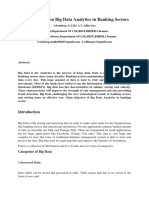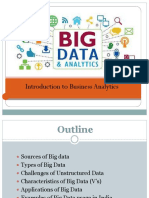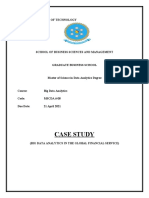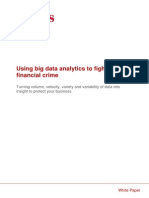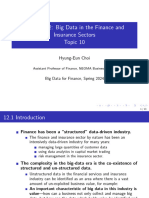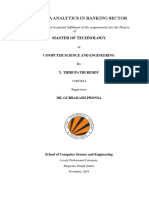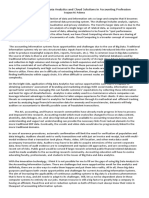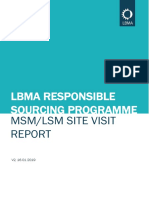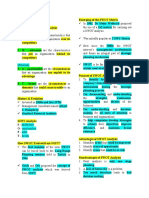BIG DATA
CASE STUDY EVALUATION
(Component 2)
Submitted By:
Khushi Mittal
20021021118
Que 1.
Insurance fraud refers to a variety of unethical behaviors that a person may
engage in in order to obtain a favorable outcome from an insurance company.
This could include arranging the incident, misrepresenting the circumstances,
including the relevant characters and the incident's cause, and lastly exaggerating
the magnitude of the harm.
Insurance claim fraud has been a problem for the insurance industry since the
beginning. On the one hand, there's the risk of affecting client satisfaction by
delaying payouts or conducting lengthy investigations at a stressful moment.
There are also investigation costs and regulatory pressure from the insurance
business. Incorrect payouts, on the other hand, reduce profitability and encourage
other policyholders to engage in similar delinquent behavior.
Advantages of handling fraud detection using analytics in Insurance companies
are:
• Identification of Low Incidence Events
• Data Integration
• Harnessing Unstructured Data
It should be highlighted that insurance fraud is not a victimless crime; the losses
incurred as a result of fraud affect all parties involved, including increased
premium prices, a lack of trust during the claims process, and a reduction in
process efficiency and creativity.
As a result, the insurance business has an immediate need to create capabilities
that can help identify suspected frauds with a high degree of accuracy, allowing
other claims to be processed quickly while the identified instances are thoroughly
investigated.
Que 2.
Big Data plays a critical role in propelling any industry forward. Automated fraud
detection, in the context of the financial sector and fraud detection, aims to collect
usable information to reduce financial frauds by analyzing and data mining Big
Data, particularly structured data. Even yet, the focus of Big Data applications
has shifted to supply chain management (SCM). Despite the fact that many
�aspects of Big Data have been explored and researched in SCM, there remains a
knowledge gap in the area of unstructured data for financial fraud detection.
Google Analytics can reveal a user's browsing and purchase patterns by providing
a trail of their online actions. Web analytics may help with website design,
product placement optimization, consumer transaction analysis, market structure
analysis, and product suggestions.
Few major techniques of data analysis in fraud detection are:
• Social Network Analysis: The SNA tool combines a hybrid approach of
analytical methods. The hybrid approach includes organizational business
rules, statistical methods, pattern analysis, and network linkage analysis
to really uncover the large amounts of data to show relationships via
links.. Public records such as judgments, foreclosures, criminal records,
address change frequency, and bankruptcies are all data sources that can
be integrated into a model.
• Predictive Analytics for Big Data: Big data analytics allows for the
filtering of unstructured data, which was previously impossible, as well
as the proactive detection of fraud. There has been a rise in the usage of
predictive analytics technology, which is part of the big data analytics
idea, to identify possibly fraudulent claims and expedite payment of real
ones.
• Social Customer Relationship Management: Social CRM takes data from
multiple social media networks and integrates it with a company's
existing CRM. It extracts data from social chatter using a 'listening'
technology, which serves as a reference for the existing data in the CRM.
A case management system receives the reference data as well as
information from the CRM. After that, the case management system
examines the data. For example, in the case study, AXA OYAK, a
Turkish insurance firm, used the SAS Social CRM solution to manage
risk and avoid fraud. AXA OYAK created an intelligent enterprise based
on social CRM, which integrates all customer-related data into a unified,






